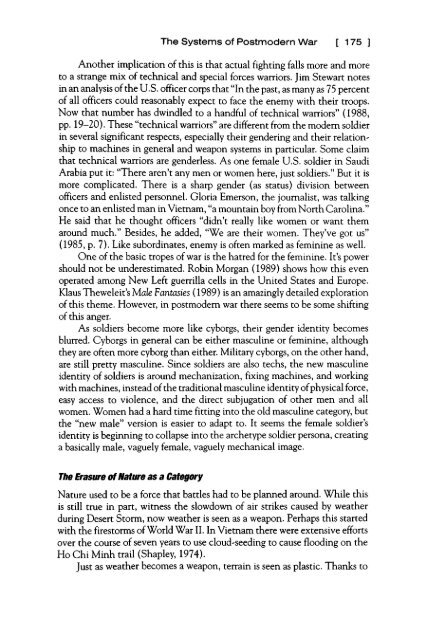9. The Systems of Postmodern War - Chris Hables Gray
9. The Systems of Postmodern War - Chris Hables Gray
9. The Systems of Postmodern War - Chris Hables Gray
You also want an ePaper? Increase the reach of your titles
YUMPU automatically turns print PDFs into web optimized ePapers that Google loves.
<strong>The</strong> <strong>Systems</strong> <strong>of</strong> <strong>Postmodern</strong> <strong>War</strong> [ 175 ]<br />
Another implication <strong>of</strong> this is that actual fighting falls more and more<br />
to a strange mix <strong>of</strong> technical and special forces warriors. Jim Stewart notes<br />
in an analysis <strong>of</strong> the U.S. <strong>of</strong>ficer corps that "In the past, as many as 75 percent<br />
<strong>of</strong> all <strong>of</strong>ficers could reasonably expect to face the enemy with their troops.<br />
Now that number has dwindled to a handful <strong>of</strong> technical warriors" (1988,<br />
pp. 19-20). <strong>The</strong>se "technical warriors" are different from the modern soldier<br />
in several significant respects, especially their gendering and their relationship<br />
to machines in general and weapon systems in particular. Some claim<br />
that technical warriors are genderless. As one female U.S. soldier in Saudi<br />
Arabia put it: "<strong>The</strong>re aren't any men or women here, just soldiers." But it is<br />
more complicated. <strong>The</strong>re is a sharp gender (as status) division between<br />
<strong>of</strong>ficers and enlisted personnel. Gloria Emerson, the journalist, was talking<br />
once to an enlisted man in Vietnam, "a mountain boy from North Carolina."<br />
He said that he thought <strong>of</strong>ficers "didn't really like women or want them<br />
around much." Besides, he added, "We are their women. <strong>The</strong>y've got us"<br />
(1985, p. 7). Like subordinates, enemy is <strong>of</strong>ten marked as feminine as well.<br />
One <strong>of</strong> the basic tropes <strong>of</strong> war is the hatred for the feminine. It's power<br />
should not be underestimated. Robin Morgan (1989) shows how this even<br />
operated among New Left guerrilla cells in the United States and Europe.<br />
Klaus <strong>The</strong>weleit's Male Fantasies (1989) is an amazingly detailed exploration<br />
<strong>of</strong> this theme. However, in postmodern war there seems to be some shifting<br />
<strong>of</strong> this anger.<br />
As soldiers become more like cyborgs, their gender identity becomes<br />
blurred. Cyborgs in general can be either masculine or feminine, although<br />
they are <strong>of</strong>ten more cyborg than either. Military cyborgs, on the other hand,<br />
are still pretty masculine. Since soldiers are also techs, the new masculine<br />
identity <strong>of</strong> soldiers is around mechanization, fixing machines, and working<br />
with machines, instead <strong>of</strong> the traditional masculine identity <strong>of</strong> physical force,<br />
easy access to violence, and the direct subjugation <strong>of</strong> other men and all<br />
women. Women had a hard time fitting into the old masculine category, but<br />
the "new male" version is easier to adapt to. It seems the female soldier's<br />
identity is beginning to collapse into the archetype soldier persona, creating<br />
a basically male, vaguely female, vaguely mechanical image.<br />
<strong>The</strong> Erasure <strong>of</strong> Nature as a Category<br />
Nature used to be a force that battles had to be planned around. While this<br />
is still true in part, witness the slowdown <strong>of</strong> air strikes caused by weather<br />
during Desert Storm, now weather is seen as a weapon. Perhaps this started<br />
with the firestorms <strong>of</strong> World <strong>War</strong> II. In Vietnam there were extensive efforts<br />
over the course <strong>of</strong> seven years to use cloud-seeding to cause flooding on the<br />
Ho Chi Minh trail (Shapley, 1974).<br />
Just as weather becomes a weapon, terrain is seen as plastic. Thanks to








